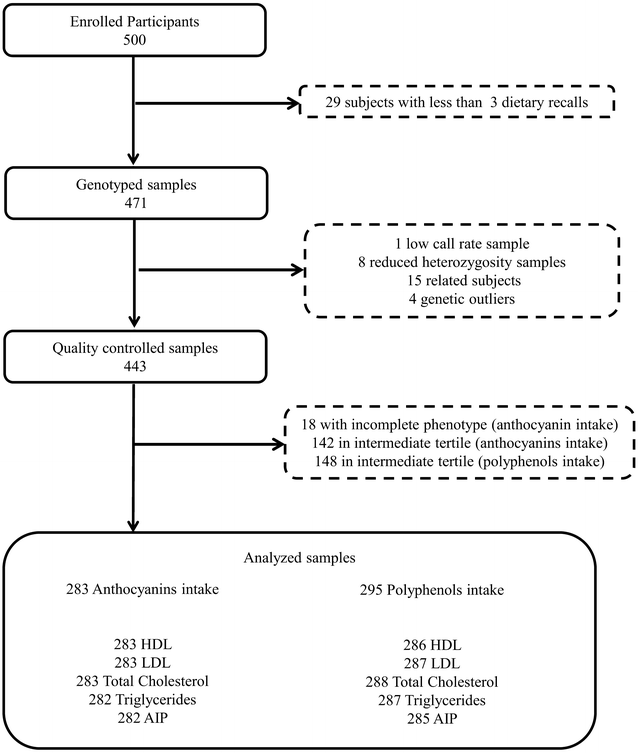Interaction between polyphenols intake and PON1 gene variants on markers of cardiovascular disease: a nutrigenetic observational study
- PMID: 27338244
- PMCID: PMC4918189
- DOI: 10.1186/s12967-016-0941-6
Interaction between polyphenols intake and PON1 gene variants on markers of cardiovascular disease: a nutrigenetic observational study
Abstract
Background: Paraoxonase 1 (PON1) gene polymorphisms and polyphenols intake have been reported independently associated to lipid profile and susceptibility to atherosclerosis and cardiovascular disease. However, the interaction between these factors remains to be investigated. We performed an observational nutrigenetic study to examine whether the interaction between polyphenols and anthocyanins intake and PON1 genetic variants can modulate biomarkers of cardiovascular health in an Italian healthy population.
Methods: We recruited 443 healthy volunteers who participated in the EC funded ATHENA project (AnThocyanin and polyphenols bioactive for Health Enhancement through Nutritional Advancement). Data collection included detailed demographic, clinical, dietary, lifestyle, biochemical and genetic data. Polyphenols and anthocyanins intake was measured by 24 h dietary recall repeated three times a year in order to get seasonal variations. We tested the interaction between 18 independent tagging SNPs in PON1 gene and polyphenols intake on HDL, LDL, cholesterol, triglycerides and atherogenic index of plasma.
Results: Without considering the genetic background, we could not observe significant differences in the lipid profile between high and low polyphenols and anthocyanins intake. Using a nutrigenetic approach, we identified protective genotypes in four independent polymorphisms that, at Bonferroni level (p ≤ 0.0028), present a significant association with increased HDL level under high polyphenols and anthocyanins intake, compared to risk genotypes (rs854549, Beta = 4.7 per C allele; rs854552, Beta = 5.6 per C allele; rs854571, Beta = 3.92 per T allele; rs854572, Beta = 3.94 per C allele).
Conclusions: We highlight the protective role of genetic variants in PON1 towards cardiovascular risk under high polyphenols and anthocyanins consumption. PON1 variants could represent novel biomarkers to stratify individuals who might benefit from targeted dietary recommendation for health promotion and strategies of preventive medicine.
Keywords: Anthocyanins; Antioxidants; Gene diet interaction; Genetic variants; HDL; Lipid profile; Nutrigenomics; PON1 gene; Polyphenols.
Figures


References
-
- Deaton C, Froelicher ES, Wu LH, Ho C, Shishani K, Jaarsma T. The global burden of cardiovascular disease. Eur J Cardiovasc Nurs. 2011;10(Suppl 2):S5–S13. - PubMed
Publication types
MeSH terms
Substances
LinkOut - more resources
Full Text Sources
Other Literature Sources
Miscellaneous

